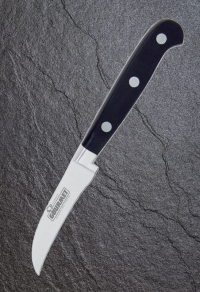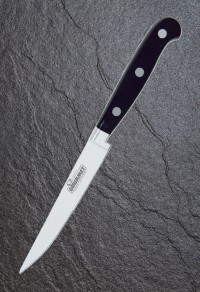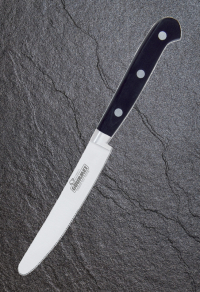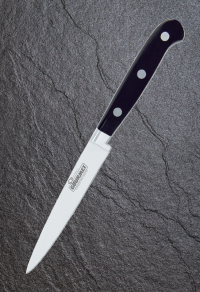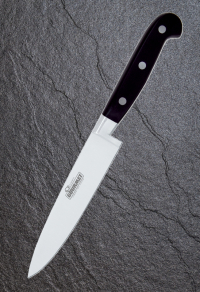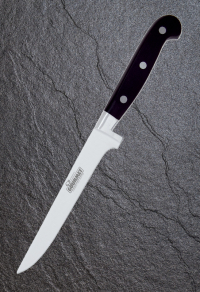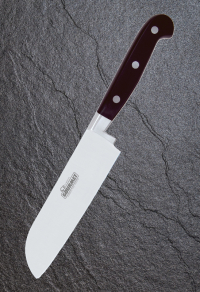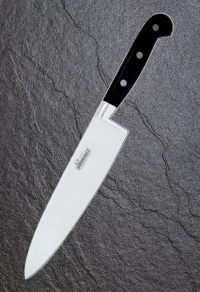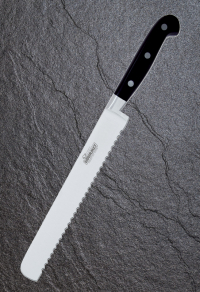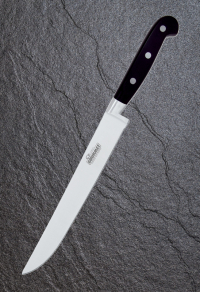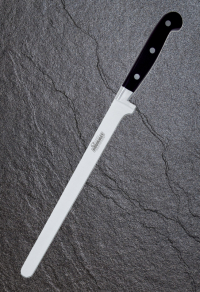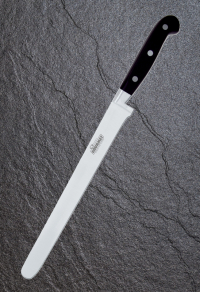
Forgiato
-
Knife VERDURA - cod. 2002
Knife with short and slightly curved blade. It allows the cleaning of vegetables and the peeling of some vegetables. The blade must cut without having to apply pressure. The blade may not even be curved but straight, but the preference falls for years on the curved one. This is the VEG knife. -
Knife BISTECCA - cod. 2004
It is the type of knife required for all red and white meats: especially steaks, chops, ribs and chops. Razor-sharp blades with teeth designed to crush the slices without damaging them. -
Knife TAVOLA - cod. 2005
Suitable for bread, desserts, and all foods in general with the exception of grilled meat and griddle
-
Knife SPELUCCHINO - cod. 2003
In the kitchen knife category, the PARING KNIFE represents a knife in its own right. It is a "joker" tool used by both the professional and the housewife. The particular shape of the blade allows processing -
Knife CUCINA - cod. 2006
Together with the knife for vegetables it is probably the most used, as it can be used on a wide variety of foods and for a long series of operations. For example, it is able to chop, chop, reduce into cubes and slice meat, fish and vegetables. -
Knife DISOSSO - cod. 2013
In the kitchen we often find ourselves working cuts of meat of different sizes and we need to separate the bones from the meat. DEBONING knives cater to this need: they can have a STRAIGHT or slightly CURVED blade to absorb the different types of cuts and shapes of the animals, making the preparation of the meat easier. -
Knife SANTOKU - cod. 2016
The Santoku knife represents the Japanese equivalent of the European chef's knife (CHEF KNIFE). Characteristic Japanese knife used to cut and chop vegetables. For this operation - in fact - Western cooks use the knife called CHEF KNIFE The big difference between the two blades is that the carving knife is designed so that the tip always remains in contact with the cutting board, while the Santoku is used as a small cleaver and the tip always comes off the cutting board.
-
Knife TRINCIANTE - cod. 2008
This model of knife allows the most varied workings and is certainly the tool that spends the most time in the hands of a Western chef. It has always been the knife with which everything is more or less everything on the cutting board. Excellent for shape and size for cutting, chopping, dicing and generally slicing any type of food: meat, fish, vegetables, fruit and semi-rigid or rigid cheeses. When choosing a carving knife, always check to have the space on the cutting board to be able to use it without damaging the tip near other objects and bearing in mind the fact that you will often have to use it as a guillotine, keeping the tip close to the cutting board and moving the initial part of the blade. A valid alternative - for the professional - to the classic domestic crescent. -
Knife PANE - cod. 2012
Slicing bread precisely and serving beautiful slices is a daily action. In addition, cakes, casseroles, roulades and other savory or cheesy preparations require a precise cut without having to pressurize the food, and this blade facilitates cutting.The tip is not needed and the blade must be wavy so as to incise the crust slowly without breaking it. -
Knife ARROSTO - cod. 2011
They are knives with a blade geometry designed to offer the least resistance when cutting the food. SPINE and EDGE of the blade, generally "run" in parallel way just for this reason. Extremely sharp and with a tip pointing upwards to facilitate cutting the slices. Blade length between 20 and 30 centimeters.
-
Knife PROSCIUTTO - cod. 2014
Type of blade fundamental for slicing salami, hams and smoked salmon (in this case the blade is alveolar). Characterized by a long blade that minimizes cut resistance, facilitating the progression and maintenance of the thin thickness required for these foods. Also available flexible. -
Knife SALUMI - cod. 2015
Very important for slicing meats and hams and salmon if it has a blistered blade. They have a long (possibly hollow) and very flexible blade.

